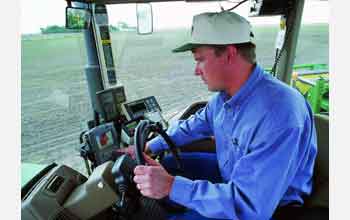Multimedia Gallery
ATE Centers (Image 3)
Precision farming uses global positioning systems (GPS) and geographic information systems (GIS) technologies to maximize crop management efficiency. The National Resource Center for Agriscience and Technology Education (AgrowKnowledge) offers courses on precision farming for faculty to teach them how to better incorporate GPS/GIS technologies into their classrooms. The goal of precision farming is to improve farmers' profits and harvest yield, while reducing the negative impacts of farming on the environment that come from over-application of chemicals. [Image 3 of 12 related images. See Image 4.] (Date of Image: 2009)
More about this Image
AgrowKnowledge, a National Science Foundation (NSF) Advanced Technological Education (ATE) center, offers courses on precision farming for faculty to teach them how to better incorporate GPS/GIS technologies into their classrooms. With precision farming, the use of GPS and GIS systems allow farmers to more accurately assess a situation before making decisions, and allows them to tailor their methods for treating their crops with fertilizers and pesticides, so that only the precise area that needs the treatment is affected. This helps with the environment by cutting down on the use of pesticides in areas of a field where it is not needed. Many new pieces of farm equipment are being offered with this capability.
For example, with precision farming, a farmer riding in a tractor in a field early in the growing season can turn on a GPS monitor in the cab and pinpoint their exact location in the field to within 1 meter. Next, they display a series of GIS maps that shows them where the soil in the field is moist, where it has eroded over the winter and where there are factors within the soil that may inhibit crop growth, such as weed or pest infestations. The farmer then uploads remote sensing data collected the previous day that shows them where their crops are already thriving and where they are not. The data is then uploaded into an onboard machine that automatically regulates the application of fertilizer and pesticides, dispensing just the right amount and in the precise location needed. Dozens of farmers in the U.S. and Canada are already using satellite and aircraft remote sensing data to manage their crops more effectively and efficiently.
AgrowKnowledge is a national partnership of community colleges whose work is enhanced by the involvement of business and industry, leading universities in agriculture education, secondary schools and professional associations. AgrowKnowledge understands the increasing demand for high-tech careers in areas such as precision agriculture, biotechnology, alternative energy production, natural resource management and nutritious food production. AgrowKnowledge partners prepare students for the workforce by teaching them to use emerging technologies in agriculture, food and natural resources. AgrowKnowledge is located at Kirkwood Community College in Cedar Rapids, Iowa. To learn more, visit the center's website Here.
NSF's ATE program supports efforts to improve the knowledge and skills of technicians who work in high-technology fields that drive the nation's economy. The program focuses on undergraduates, secondary school students and incumbent technicians, as well as on the educators who teach them. Community colleges are the main provider of education for technicians and have leadership roles in all ATE initiatives, working closely with industry, government and educators in other sectors to enhance the skills of the men and women who are essential to the vitality of the nation's economy. ATE partnerships help create new curricula; reform existing programs; enrich the technical knowledge of experienced college faculty members and teachers; prepare prospective educators with solid foundations in science, technology, engineering and mathematics; and undertake applied research in technological education. Further information on NSF's ATE program is available Here. [AgrowKnowledge is funded in part by NSF grant DUE 08-02510.]
Credit: Photo from ATE Centers Impact 2008-2010 (www.atecenters.org)
Images and other media in the National Science Foundation Multimedia Gallery are available for use in print and electronic material by NSF employees, members of the media, university staff, teachers and the general public. All media in the gallery are intended for personal, educational and nonprofit/non-commercial use only.
Images credited to the National Science Foundation, a federal agency, are in the public domain. The images were created by employees of the United States Government as part of their official duties or prepared by contractors as "works for hire" for NSF. You may freely use NSF-credited images and, at your discretion, credit NSF with a "Courtesy: National Science Foundation" notation.
Additional information about general usage can be found in Conditions.
Also Available:
Download the high-resolution JPG version of the image. (1.7 MB)
Use your mouse to right-click (Mac users may need to Ctrl-click) the link above and choose the option that will save the file or target to your computer.



